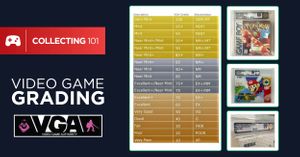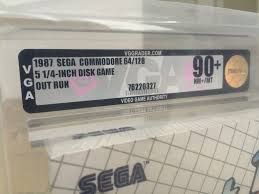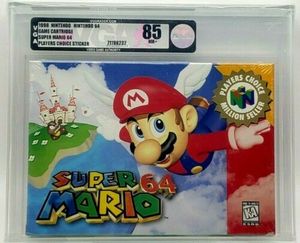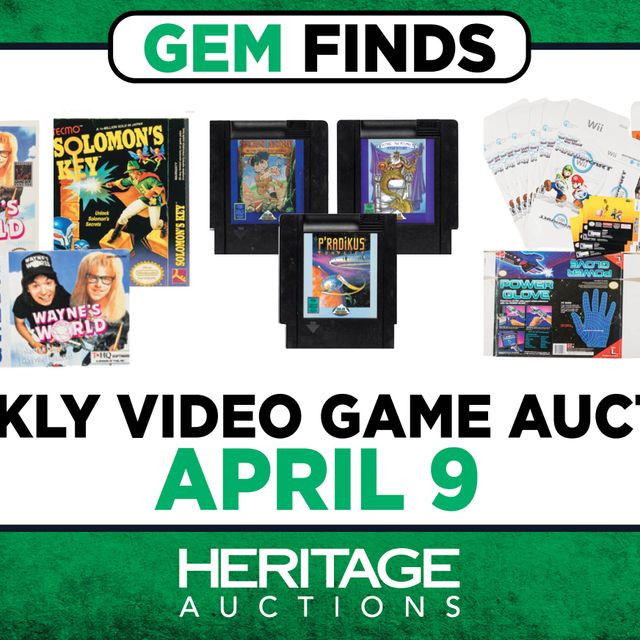
VGA operates under its parent company, Collectible Grading Authority(CGA), which was recently acquired by Diamond Comic Distributors. Founded in 2000, CGA grades Action Figures, Dolls, Die-Cast figures, and expanded into Video Games in 2008, becoming the first company to be offering video game grading. This department was dubbed Video Game Authority. Since then, they've graded thousands of games and continue to maintain a steady log of incoming orders.
The Basics
VGA has two grading scales for their games; a Standard Grading Scale and a Qualified Grading Scale. The Standard scale is used for sealed/new-in-package items. Their Qualified Grading Scale is used for opened game packages with new contents, which must be accompanied by documentation. Both scales are used for all video games, systems, and accessories from any era.
Standard & Qualified Grading Levels
Both scales use an identical grading system. VGA grades range from 10 to 100 based on the item's condition overall. Within the 1 - 100 ratings are three grading levels - Gold, Silver, and Bronze.
 Gold Level
Gold Level
The VGA Gold level consists of the grades 100, 95+, 95, 90+, 90, and 85+. A Gold Level graded game means that the game is nearly visually perfect, with only the smallest of blemishes allowed.
Any minute flaw may knock the game down a few points, and the few games that achieve this level can be trusted to be of the highest quality. This level is not achieved by many games, as "perfection" is obviously difficult to obtain.
Silver Level
The VGA Silver level consists of grades 85, 80+, 80, 75+, and 75. The Silver level represents a much larger number of submitted games than the Gold Level and also represents a far greater range in quality. 
To break it down further, a grade of 85 may represent a game that only received a small amount of wear through transit, though looks to be in fantastic condition.
A score of 80 may apply to games that have spent a bit of time on a store shelf before being purchased and preserved. It may have slightly more noticeable flaws when inspected.
Games that land in the lowest Silver grade, 75, will have noticeable flaws, including tears in the shrink wrap. Still, it should not have flaws that immediately draw the eye. 
Bronze Level
The largest of the levels, VGA Bronze, consists of grades 70 and below. This level encompasses all other levels of damage, all the way down to obviously poor condition games. These grades will include games with crushed or cracked boxes, creasing, paper tears, and significant fading.
Common Defects Factored into Grading
As with any other collectibles grading system, there are several factors that are taken into account when grading video games. When assigning a grade, all will be taken into account collectively. Here are a few the graders will watch for:
Cellophane, or Shrink-Wrap: The cellophane, or clear outside wrapping of the game, will be judged against dents, scratches, fading, yellowing, clouding, sticker residue, tearing, cuts, lifting, soiling, rub marks, tearing, factory cut, and foreign items like ink marks or staples. Any one of these issues will bump the game down in grade. 
Box: The game's box will be judged against creasing, bending, rolling, tearing, scuffing, scratching, lifting, print marks, loss of gloss, soiling, discoloring, edge wear, nicks, punctures, ink or foreign markings, peg hole punch, tape repair, focus, price sticker, sticker tear, sticker residue, water damage, bubbling, and attached foreign objects.
Price Stickers: The presence of price stickers is not generally considered a major flaw, but can become a detrimental factor if curling, tearing, staining, picking, etc. of the sticker has occurred. The location of the sticker can also affect the grade if it blocks the cover's art or other important markings.
What to Expect from the Submission Process
Ok, you've chosen VGA and you're ready to submit your game. Now what?
You must fill out a submission form to accompany your game before mailing. This can be submitted online (after the creation of a free account), or it can be printed and filled out by hand to be physically mailed with your submission. Instructions on how to do so can be found here. It is on this form that you will list details, known flaws, and the general condition of your item, as observed by you.
Submission Received - Your game is officially submitted after it arrives at the grading facility, is unpacked, and checked in. The graders will then look over your submission to confirm that the information you included on your submission form is accurate. Sometimes, if a game has been described inaccurately, the error will create a pricing discrepancy. If the total cost of the change is under $20, the cost will be adjusted automatically. If the change in cost is over $20, you will be contacted to determine how you'd like to proceed. After this step is completed, you will receive an email confirming your submission has been accepted and accurately invoiced.
Preliminary Grading Stage - Either a Junior or Senior-level grader will examine your item. (Junior graders typically have over 2 years of experience, while Senior graders will usually have 5 to 8 years under their belts.) They will document any and all issues, including box/shrink wrap flaws, tampering, restoration, and verify that the item is authentic. If the item is confirmed as original and slated to be slabbed/cased, the grader will put in a production order to the fabrication department to begin manufacturing the grading slab and other materials.
Final Grading / Double-Checking Stage - The final step before slabbing is for a Senior grader to review the notes of the original grader. As long as that grader agrees with the original rating, the game will be passed on to the casing stage. If there is a disagreement in grade, the Senior grader will consult with the original grader to reach an agreement on an acceptable grade.
Casing Stage - Next, the appropriate grade label for your graded game is printed and sealed inside the acrylic case designed to fit your specific game. Before the game is sealed inside its slab, it will receive one final check by a Senior grader for accuracy of label and rating. The game is then permanently sealed inside.
After all steps are completed, your game is packaged and sent back to you.
How Much Will it all Cost? 
The cost to have your game graded varies based on the physical size of the game and its worth. For regularly sized games with a max value of $5,000, the cost to grade is $90. Regularly sized games with a max value of $100,000 cost $125 for grading. Costs go up for larger or abnormally sized games. There are typically two additional tiers for lower-valued games, but both are currently closed. VGA offers discounts in exchange for a membership with the company.
Are you grading your video games yet? We hope this helps! Happy gaming, happy grading, and, most importantly, happy collecting!
Our Video Game Price Guide is LIVE! Check it out today, then upgrade to GoCollect PRO for access to all the newest tools for collectors!
*This piece was not sponsored nor requested by VGA. All prices and information accurate at the time of writing, 10/18/21





